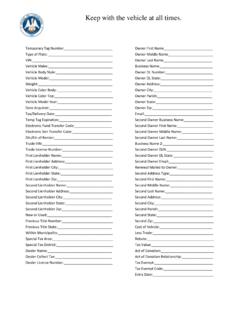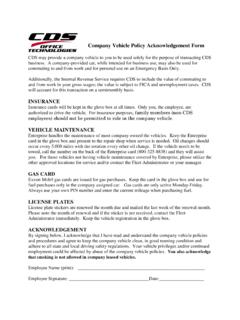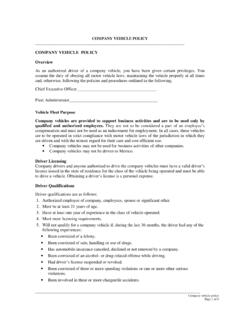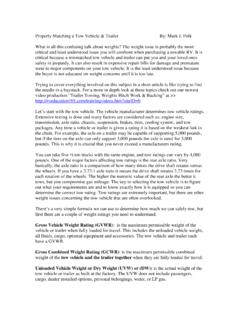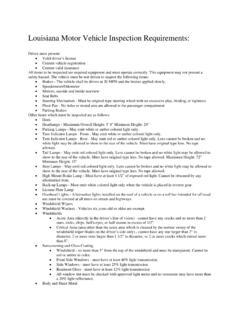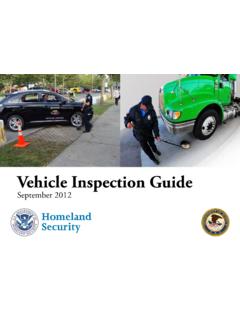Transcription of Vehicle Safety Training - Updated Pre-Service is …
1 Presented By:Tymothy SmithEarly Care and EducationTraining and Consulting(214) for Drivers: Must be at least 21-years of age Must have a valid Texas drivers license Must be familiar with the use of a fire Drivers should always avoid backing up. This prevents the risk of accident or injury. Stick to the route or directions that the program assigned for the trip. Do not make exceptions. In the event of a detour, notify the program immediately. Cell phones should not be used while operating a Vehicle . In the event of an incident and a phone call is needed, the driver should pull the Vehicle off the road and into a safe lot to make or take the phone call. This includes blue tooth and earpieces. Always allow 4 seconds of driving space between your Vehicle and the Vehicle in front of you. Check mirrors every 30 seconds. When at an intersection with no signs or signals, the driver should always stop, look both ways, and proceed with caution.
2 When at a stop light and the light turns green, the driver should allow the full length of the Vehicle to gain between you and the Vehicle in front of you before you move. In the event that brakes fail, pump your breaks to build pressure. The driver should read the operating guide to all vehicles to become aware of additional or optional emergency procedures specific to that brand of Vehicle . In the event that the accelerator gets stuck, the driver should not reach down with his or her hands to try to release the accelerator. When operating a Vehicle , it is not advised to wear sandals or flip-flops. These types of shoes can cause the driver to get the sandals caught in the accelerator. In the event of hydroplaning, the driver should take his or her foot off the gas pedal and continue driving straight ahead without applying the brakes. Before moving a Vehicle , the driver should walk around the Vehicle to insure that no obstacles are present.
3 Each Vehicle should contain an emergency notebook. There should be at least one fire extinguisher on each Vehicle . These items should be checked monthly. Each driver should take a written driving test before operating a Vehicle . Each driver should take a driving test with the program director before transporting children. Vehicle emergency notebook should include all of the following items: All bus routes to each school from the program as well as routes from school to school (if applicable). Internet map services work well for these criteria. List of all Elementary schools, phone numbers, Principles name, and school Attendance Clerks name. Missing children procedures. Vehicle loading and unloading The following information on each transportable child in the entire program, in alphabetical order: Copy of completed registration form. Health forms listing any special medical attention.
4 Emergency Medical Authorization form. Program Directors business card with $.50 taped to the back of the Children are never allowed to enter or exit the Vehicle by themselves. Children should be loaded and unloaded at the curbside of the Vehicle or in a protected parking area or driveway. Children should not be allowed to cross a street any time before entering or after leaving a Vehicle unless accompanied by an adult. All children exiting the Vehicle must be accounted for prior to leaving the Vehicle unattended. Never leave a child unattended in a Vehicle . The Vehicle emergency notebook must be in the Vehicle at all times during use and information must be Updated before a new child is transported. Staff/Child ratios must be maintained on vehicles at all times. The Vehicle should not be running. Turn off the engine, remove the keys from the ignition and keep in the driver s possession.
5 Set the emergency brake. The driver must exit the Vehicle and stand beside the door, personally loading the children onto the Vehicle . Always hold the door so the wind will not catch it. As children board the Vehicle , identify each child by name. Once children have boarded, take roll visually, making eye contact with each child as you check off the children s names on the Vehicle roll Visually and physically check seat belts to see that each child is secure and that there is only one child using each belt. Take a head count to match roll to identify if children are missing or if you have a child that should not be with you. If driving a van, children should never be allowed to sit in the front seat. It is suggested that children under the age of six sit in the front two rows of the Vehicle . Lock and close the door. Never allow a child to do this.
6 Driver is to circle the Vehicle to ensure it is free from obstacles-especially children. Enter the Vehicle , fasten your seat belt, adjust mirrors, and recheck that the area is free of obstacles using the mirrors. Always try to park in a manner that will allow you to pull forward and avoid situations in which you must reverse. Always observe all traffic regulations -use blinkers, always make complete stops, never run yellow lights, and drive 5 miles under the posted speed limit. Pull to the curb and unload at the curbside. The Vehicle should not be running. Turn off the engine, remove keys from the ignition and keep them in your possession, and set the emergency brake. Driver opens the exit door. Children should never be allowed to do this. Driver exits the Vehicle and stands outside the exit door, holding the door to keep the wind from catching it.
7 The driver assists children as they exit the Vehicle . The driver should always remind the children to walk directly into the school. Driver should observe the children entering the elementary school before pulling away from the curb. After dropping off all children, the driver walks the Vehicle to see that no children remain on the Vehicle . A second adult should come and also walk the Vehicle to ensure that no children are left The driver walks the Vehicle , counting children on the Vehicle that are to be unloaded. The number should be written down on the bus log. Wake any sleeping children and assist any children that need help unbuckling their seat belts. Assist the children off the Vehicle . Have the children form a line on the curb or sidewalk close to the Vehicle . Once the children are unloaded, take roll visually, making eye contact with each child as you check off children s names on the bus log.
8 Match the head count number to the total count noted on the bus log. The children are escorted into the building. An adult inside the program then checks roll using the bus log once again. The driver returns to the Vehicle , walks the Vehicle again to ensure that no children were left on-board. The driver parks the Vehicle in its designated parking space. rely on verbal responses from the children. Always do visual checksbefore marking a child present. Child/Staff ratio must be met at all times. Always try to have two adults on a Vehicle if possible. Never let a child ride in the front seat of a Vehicle . Adults and children must wear seat belts at all times. First aid supplies are checked weekly. Vehicle notebook is checked and Updated weekly. Permission slips and other forms are prepared for field trips in Always visually check the children by name and face.
9 Do not rely on head counts. Teachers are not on field trips for their pleasure. Teachers are there to supervise the children and make sure they are safe and having fun. Never leave windows down when a Vehicle is parked and unsupervised. Pre-recorded music is played in all vehicles. Do not turn on the radio. Always plan to be back at your program 15 minutes prior to your planned arrival Your Vehicle is a moving billboard for your program. Adults are never allowed to sleep on a Vehicle or field trip. Always follow car-pooling guidelines. Always assist children on and off the Vehicle . Always carry your programs business cards and marketing If you have a combination of vans and mini-busses, the bus always takes the lead. Adult passengers should have two-way radios to communicate from Vehicle to Vehicle . Drivers should not have these. Two-way radios are used for car-pooling communication only and not games.
10 Program vehicles should always stay in a line and in the same lane. When changing lanes, all vehicles will turn on their turn signals. The last Vehicle in line moves over first, allowing room for Vehicle in front of them to move over, and ECT. Always plan ahead for lane changes. Stay in the right lane as much as possible. Remember to always drive 5 miles per hour below the speed One(done withoutthe children in the Vehicle ) Driver adjusts seats and mirrors. Driver fastens his or her seat belt. Driver makes sure that all doors are closed and locked. Driver exhibits knowledge of the fire extinguisher and its Driver signals intention to enter traffic (uses Vehicle blinkers). Enters traffic smoothly. Signals lane changes and turns. Makes complete stop at stop signs. Allows 4 seconds following distance behind other vehicles. Stops Driver uses mirrors.




